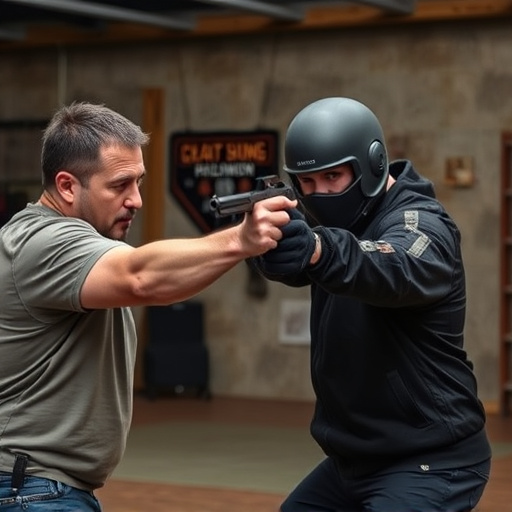Stun guns, using high-voltage electrical pulses, temporarily disable targets by disrupting nervous system activity, with rare serious physical harm or permanent neurological side effects. Effectiveness and potential risks depend on voltage (3,000-20,000V), electrode design, and duration; proper training is vital. Safety precautions include keeping them away from children and storing responsibly to avoid accidental shocks. Modern stun guns have advanced safety features, with reputable manufacturers recommending 50,000-150,000V ranges to minimize risks like muscle convulsions and disorientation. Understanding voltage levels, best practices, legal implications, and device capabilities ensures responsible use while mitigating neurological side effects.
“In today’s world, understanding personal defense options is paramount. This article delves into the critical aspects of stun gun voltage, exploring the safety specifications that define their effectiveness and potential risks. From the basic range of stun gun voltage to the neurological side effects, we dissect the science behind these devices. Learn about mitigating risks and legal implications, ensuring informed decisions in an era where self-defense technology evolves rapidly. Discover the key specs and potential drawbacks of stun guns, including their impact on the nervous system.”
- Understanding Stun Gun Voltage: The Basic Range
- Neurological Impact: A Closer Look at Stun Gun Side Effects
- Safety Specifications: What to Expect from Modern Stun Guns
- Mitigating Risks: Precautions and Best Practices
- Legal Implications: Knowing the Limits and Boundaries
Understanding Stun Gun Voltage: The Basic Range

Stun guns operate by delivering a high-voltage, low-amperage electric shock to temporarily incapacitate a target. Understanding the voltage range is crucial when considering stun gun safety and effectiveness. The typical stun gun emits between 3,000 and 15,000 volts, with some models reaching up to 20,000 volts. This voltage is designed to disrupt the electrical activity of the body’s nervous system, causing muscle contractions and disorientation. However, it’s important to note that while these shocks are painful, they rarely cause serious physical harm or permanent neurological side effects when used as intended.
The effectiveness of a stun gun depends not only on voltage but also on other factors like electrode design and current flow duration. Users should be aware that higher voltages don’t automatically translate to better performance; proper training and understanding of the device are equally important. In terms of safety, it’s crucial to keep stun guns out of the reach of children and to store them responsibly to prevent accidental shocks or misuse, regardless of the voltage range.
Neurological Impact: A Closer Look at Stun Gun Side Effects

Stun guns, while designed as non-lethal self-defense tools, do have measurable neurological side effects. When activated, a stun gun delivers an electric shock that disrupts muscle control by overloading nerve signals to the brain. This disruption can cause temporary but significant physical and cognitive impairments in the target.
The electrical current from a stun gun can result in symptoms like disorientation, confusion, dizziness, and even temporary memory loss. In some cases, it may trigger more severe neurological reactions, especially if the shock occurs near the head or neck area. Understanding these potential side effects is crucial for users to recognize and respond appropriately, ensuring safety not just for themselves but also for bystanders.
Safety Specifications: What to Expect from Modern Stun Guns

Modern stun guns are designed with advanced safety features and specific performance parameters to ensure their effectiveness while minimizing potential risks. One of the critical aspects that users should be aware of is the voltage range and its impact on safety, particularly regarding neurological side effects. Stun guns deliver an electric shock through high-voltage, low-current electrical pulses, targeting nerve impulses in the body. The voltage range typically varies from 50,000 to 150,000 volts, but some advanced models offer adjustable settings.
While stun guns are non-lethal weapons intended to temporarily incapacitate a target, excessive voltage can lead to serious neurological side effects, including muscle convulsions, disorientation, and even respiratory distress. Therefore, reputable manufacturers emphasize the importance of using stun guns within recommended voltage limits. Understanding these safety specifications is crucial for responsible use, ensuring that individuals employ the device as intended without causing unintended harm.
Mitigating Risks: Precautions and Best Practices

When using a stun gun, mitigating risks and understanding best practices is paramount to ensure safety. One crucial aspect to keep in mind is the potential for neurological side effects at different voltage levels. Stun guns deliver an electric shock designed to temporarily incapacitate a target, but higher voltages can lead to more severe consequences, including cardiovascular distress and, in rare cases, long-term neurological damage. Therefore, it’s essential to stay within recommended voltage ranges—typically between 5,000V to 15,000V—to minimize these risks.
Best practices include proper training, understanding the stun gun’s specifications, and being mindful of environmental factors. Always follow manufacturer guidelines for usage and maintenance. Avoid targeting sensitive areas like the neck or head, as this can increase the likelihood of adverse effects. Additionally, be aware that stun guns are not foolproof; they rely on physical contact to deliver a shock. Inconsistent or improper use could lead to reduced effectiveness. Thus, continuous learning and adaptation in techniques are vital to ensure safety and efficacy when employing a stun gun.
Legal Implications: Knowing the Limits and Boundaries

When considering a stun gun for self-defense, understanding its voltage range and associated safety specs is paramount. It’s crucial to know that while higher voltage can enhance stun effectiveness, it also carries more legal implications. Each jurisdiction has specific laws dictating the maximum allowed voltage for stun devices, designed to balance personal protection with public safety. Exceeding these limits can result in severe penalties, including fines and imprisonment.
Moreover, stun guns at higher voltage ranges carry potential neurological side effects. While not always guaranteed, excessive voltage could lead to temporary or even permanent nerve damage, especially if the device is misused or deployed against vulnerable individuals. Therefore, it’s essential to familiarize yourself with both local regulations and the device’s capabilities to ensure responsible use and avoid unintended consequences, including the stun gun’s neurological side effects.
Stun guns, while designed for personal safety, come with a range of voltage levels and specific safety specifications. Understanding the neurological impact of these devices is crucial, as their stun current can cause temporary paralysis and other side effects. By adhering to best practices and knowing the legal boundaries, users can mitigate risks effectively. Staying informed about stun gun safety specs, especially regarding potential neurological side effects, is essential for responsible ownership and safe usage in emergency situations.
